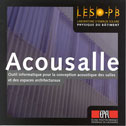A computer program with expertise for the planning and analysis of the acoustics of indoor spaces

Authors : A. Faist, S. Citherlet and F. Di Pasquale
Last program version: 1997, available in French and English, not adapted to latest Windows operating systems, no longer supported
The “ACOUSALLE” software allows a first sizing of various indoor spaces (offices, class rooms, small auditoriums, industrial halls etc.) in accordance with the established rules of geometrical, wave and statistical acoustics.
It also analyses the users’ individual proposals through a built-in expert system. A data bank of the acoustic properties of building materials allows quick calculation of the reverberation time of the planned or existing acoustic spaces.
Furthermore, ACOUSALLE can very easily verify the compliance of a given project with the Swiss acoustics regulations.
Objectives
In most of the architectural projects, acoustics are not considered at the beginning of the design work, but only at the end. Thus, most of the time, acoustic engineers are faced with difficult problems that could have been avoided if a correct approach had been chosen from the beginning. This is not only true for elaborate designs such as concert halls or operas, but also for very common spaces such as classrooms, small auditoriums or industrial halls. In developing the ACOUSALLE software, we aimed to produce a simple tool which would advise architects at the very beginning of the design stage and would allow quick and easy verification of the compliance of a given project to acoustics regulations.
The way it works
The available literature features extensive data regarding the fundamental laws of geometric wave and statistical acoustics. From these laws, a complete set of rules has been derived regarding in priority
- the acceptable pathway difference between direct and first reflected acoustic waves (geometrical acoustics)
- the acceptable space geometry: first approximation shoe box length to width to height ratios (wave acoustics)
- the recommended volume per occupant
- and the recommended reverberation times (statistical acoustics).
Taking into account a couple of secondary architectural data (such as the probable ceiling height), one gets a complete set of equations that enable the program to propose a first geometrical design of the desired space (near to shoe box shape).
Input data
In order to obtain a first geometric proposal for the planned space, only a very limited number of data is needed:
- date
- name of the project
- assignment of space
- space typology
together with at least one of the following data:
- floor area (stall floor and circle if any)
- number of seats (stall and circle if any)
- ceiling height
- width
- or length of space.
The assignment of the space has to be chosen in the following list (to be extended):
- conference room
- class room/auditorium
- seminar room
- rehearsal room (music, theatre)
- office (large size, current size)
- industrial premises, workshops.
The space typology available is the following:
- flat room
- flat room with circle
- sloped floor (auditorium, conference room)
- sloped floor with circle.
Output data
Based on the mentioned input data, the ACOUSALLE program is able to compute a first proposal of the desired space, complying with the basic rules of acoustics. This first proposal is not constraining but can be changed at will by the user. At each change, ACOUSALLE checks all the given acoustics rules and if necessary, prompts the necessary remarks regarding for example:
- bad floor length/width ratio
- excessive direct to first reflection sound path length difference (echo)
- insufficient or excessive ceiling height etc.
Once the geometry has been chosen, the program proceeds to the reverberation time calculation (according to Sabine’s formula). One gets automatically a first approximation of the various surface areas (floor, ceiling, walls etc.). The type of material is to be selected in a material data bank that allows the computation of the expected reverberation times (Fig. 1; low, medium and high frequencies). The program then automatically checks the compliance with the recommended values which correspond to the assignment of the space. A graphic output is available and completed, if necessary by detailed remarks (Fig. 2 low, medium and high frequencies).
Other features of the program
New and more restrictive regulations have recently been set up in Switzerland (noise protection in buildings, SIA 181 standard). ACOUSALLE allows a quick and user-friendly verfication of the compliance of a given design with these new standards, avoiding the user long and boresome calculations (Fig. 3). It also allows the research of new solutions based on the extensive building materials and components (windows, doors etc.) data base.
This data bank gives (in octave bandwidth) the absorption coefficients of a wide variety of materials, components and furniture. It can be completed by the user at any time.
The reverberation times are given in octave bandwidth and graphically compared to recommended values for the given space.
The calculation takes into account de nuisance level and sensitivity level of the sound producing and sound receiving rooms. Positive or negative remarks are prompted according to the achieved sound insulation level (SIA 181).
Based on measured third octave noise reduction levels, the normalised noise reduction level is computed according to ISO 717/1.
Conclusion
At the present state, ACOUSALLE is able to handle a large variety of spaces with the approximate shape of a shoe box. It offers a comprehensive material data bank that can be completed at any time by the user. The forthcoming improvements are the following:
- new space assignments such as corridors and staircases, restaurants, cafeterias, sports facilities
- better graphic output data
- three dimensional space representation.
It is worth recalling that ACOUSALLE is not aiming to design elaborate spaces such as large concert halls or operas.
FAQ: Yes, it is possible to add new materials
Reference
ACOUSALLE, a computer program with expertise for the planning and analysis of the acoustics of indoor spaces, computational acoustics and its environmental applications, Southampton UK, 5 to 7 april 1995.